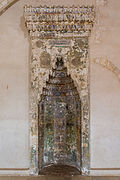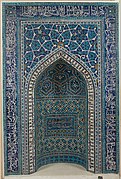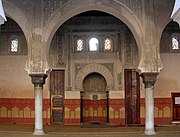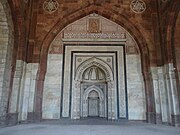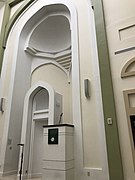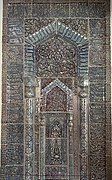Mihrab

| Part of a series on |
| Islamic culture |
|---|
| Architecture |
| Art |
| Clothing |
| Holidays |
|
| Literature |
| Music |
|
Theatre |
Mihrab (
The minbar, which is the raised platform from which an imam (leader of prayer) addresses the congregation, is located to the right of the mihrab.
Etymology
The origin of the word miḥrāb is complicated and multiple explanations have been proposed by different sources and scholars.
Arab lexicographers traditionally derive the word from the Arabic root ح ر ب (Ḥ-R-B) relating to "war, fighting or anger," (which, though cognate with the South Arabian root,
The word mihrab originally had a non-religious meaning and simply denoted a special room in a house; a throne room in a palace, for example. The Fath al-Bari (p. 458), on the authority of others, suggests the mihrab is "the most honorable location of kings" and "the master of locations, the front and the most honorable."[full citation needed] The Mosques in Islam (p. 13),[full citation needed] in addition to Arabic sources, cites Theodor Nöldeke and others as having considered a mihrab to have originally signified a throne room.
The term was subsequently used by the Islamic prophet
History

The earliest mihrabs generally consisted of a simple stripe of paint or a flat stone panel in the qibla wall.
During the reign of the
The next earliest concave mihrab to be documented is the one that was added to the

Eventually, the niche came to be universally understood to identify the qibla wall, and so came to be adopted as a feature in other mosques. A sign was no longer necessary. Today, mihrabs vary in size, but are usually ornately decorated.[citation needed] It was common for mihrabs to be flanked with pairs of candlesticks, though they would not have lit candles.[14] In Ottoman mosques, these were made of brass, bronze or beaten copper and their bases had a distinctive bell shape.[15]
In exceptional cases, the mihrab does not follow the qibla direction, such as is the Masjid al-Qiblatayn, or the Mosque of the Two Qiblas, where Muhammad received the command to change the direction of prayer from Jerusalem to Mecca, thus it had two prayer niches. In 1987 the mosque was renovated, the old prayer niche facing Jerusalem was removed, and the one facing Mecca was left.[16]
Architecture
Mihrabs are a relevant part of Islamic culture and mosques. Since they are used to indicate the direction for prayer, they serve as an important focal point in the mosque. They are usually decorated with ornamental detail that can be geometric designs, linear patterns, or calligraphy. This ornamentation also serves a religious purpose. The calligraphy decoration on the mihrabs are usually from the Qur'an and are devotions to God so that God's word reaches the people.[17] Common designs amongst mihrabs are geometric foliage that are close together so that there is no empty space in-between the art.[17]
Great Mosque of Córdoba
The mihrab in the
Great Mosque of Damascus
The Great Mosque of Damascus was started by al-Walid in 706.[21] It was built as a hypostyle mosque, built with a prayer hall leading to the mihrab, "on the back wall of the sanctuary are four mihrabs, two of which are the mihrab of the Companions of the Prophet in the eastern half and the great mihrab at the end of the transept".[21] The mihrab is decorated similarly to the rest of the mosque in golden vines and vegetal imagery. The lamp that once hung in the mihrab has been theorized as the motif of a pearl, due to the indications that dome of the mihrab has scalloped edges.[22] There have been other mosques that have mihrabs similar to this that follow the same theme, with scalloped domes that are "concave like a conch or mother of pearl shell.[22] The original main mihrab of the mosque has not been preserved, having been renovated many times, and the current one is a replacement dating from renovations after a destructive 1893 fire.[22][23][11]
Gallery
-
A mihrab in Sultan Ibrahim Mosque in Rethymno
-
Mihrab (prayer niche); 1354–1355; mosaic of polychrome-glazed cut tiles on stonepaste body, set into mortar; 343.1 x 288.7 cm, weight: 2041.2 kg; from Isfahan (Iran); Metropolitan Museum of Art (New York City)
-
Mihrab in theFes, Morocco
-
Mihrab in the Dome of the Chain, Temple Mount, Jerusalem.
-
Mihrab in the Qila-i-Kuhna Mosque, in Delhi
-
Mihrab in the Islamic Society of Boston Cultural Center, in Roxbury, Boston.
-
Mihrab ofKalyan Mosque in Bukhara, Uzbekistan
-
This mihrab is from a shrine at the tomb ofVeramin, Iran and now is installed at a museum in Hawaii.
See also
Notes
- ^ K. A. C. Creswell and some later scholars argued that the oldest surviving mihrab is a flat marble panel, known as the Mihrab of Sulayman, found in the rock-cut chamber under the Dome of the Rock in Jerusalem, which he attributed to the construction of Abd al-Malik in the late 7th century.[11] However, more recent scholarship has dated this mihrab to the 9th or 10th centuries based on stylistic, paleographic, and other historical grounds.[2] Flat mihrabs were occasionally popular in these periods under the Tulunid and Fatimid dynasties.[11][2]
References
- ^ S2CID 161470520.
- ^ ISBN 9780195309911.
- ISBN 978-90-429-0815-4. Retrieved 6 August 2021.
- ^ ISBN 9789004369993.
- ^ ISBN 978-0544454453.
- ^ Dillmann, August; Munzinger, Werner (1865). Lexicon linguae aethiopicae cum indice latino. Lipsiae, T.O. Weigel. pp. 835–836. Retrieved 6 August 2021.
- ^ Nöldeke, Theodor (1910). Neue Beiträge zur semitischen Sprachwissenschaft / von Theodor Nöldeke. Straßburg: Karl J. Trübner. p. 52. Retrieved 6 August 2021.
- ^ "Semitic Roots Repository - View Root". www.semiticroots.net. Retrieved 6 August 2021.
- ^ Sheikho, Mohammad Amin (October 2011). Unveiling the Secrets of Magic and Magicians. Amin-sheikho.com. Retrieved 6 August 2021.
- ^ ISBN 978-90-04-03813-4.
- ^ ISBN 9789004161214.
- ^ ISBN 9780300088670.
- ^ ISBN 978-0-674-46866-5.
- OCLC 455121277.
- OCLC 61177501.
- ^ "Masjid al-Qiblatain - Madain Project (en)". madainproject.com. Retrieved 2021-12-12.
- ^ a b Terasaki, Steffie. "Mihrab". courses.washington.edu. Retrieved 2019-11-05.
- ^ a b "Mihrab". Mihrab. Retrieved 2019-11-05.
- ^ "Mezquita de Córdoba | The Meaning of the Great Mosque of Cordoba in the Tenth Century". Archnet. p. 83. Retrieved 2019-11-05.
- ^ ISBN 9780195309911. Retrieved 2019-11-17.
- ^ JSTOR 1523262.
- ^ ISBN 9789004116382.
- JSTOR 1523236.

